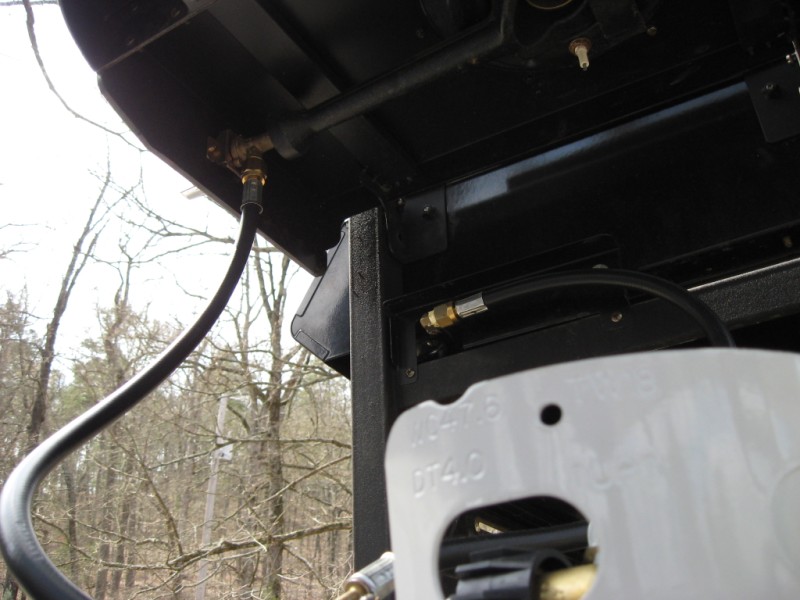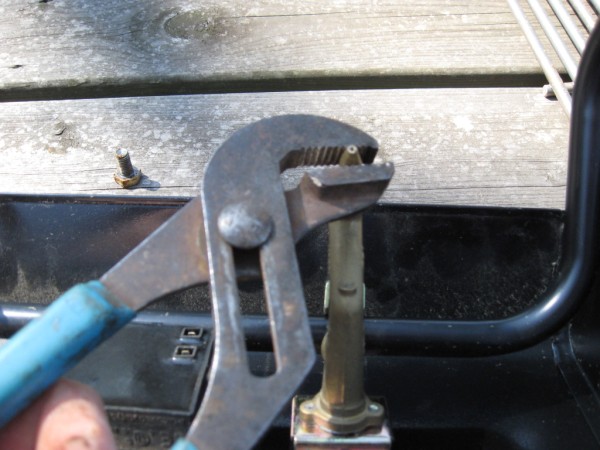No Gas to Burners
Little or no gas to your burner means that somewhere between the burners and the tank gas is flow is blocked. You can start on either end of the grill, the burners, or the tank.
If the gas is OK to one burner but low to all burners you probably have a faulty hose. Go to the second section.
Otherwise you might as well go through this whole section including cleaning and checking the burners and orifices. Always check your gas fittings for leaks when you’re done with the tank valve open and connected!
1. If you try to light your grill and get little or no flame, the first thing to check would be the tank. Is it full and the valve open? Remember to keep fire away from the grill while you do this!!!
If you’re certain that you’re OK in that area, you should start by checking the LP hose connection to the tank. With the LP tank valve closed,r emove the hose connection to the grill. Place your finger over the end of the hose and open the tank valve. Put the hose to your ear and slowly pull your finger away and listen for the flow of gas.
The hose regulator could be working partially or not at all.If you’re certain you have enough gas through the regulator hose then goto step 3.
2. A cheap easy way to check the hose would be to get a replacement at Home Depot or hardware store and replace the old one.The hose regulator can always be found together in the grill repair parts section of Lowe’s or Home Depot. They will be hard to find separately except on line and will usually cost more.
Recently, a man brought a brand new grill that was giving very little gas to the burners. One burner would get hot, but if the second and third were turned on, the gas flow would not be enough to stay lit. We replaced the hose regulator and the problem was corrected. The cost for the hose regulator assembly locally will be $15 to $25.
Some grills will have a regulator with two ends connecting to the main valve manifold and the side burner. Home Depot and Lowe’s usually have both in the grill section of their store with other repair parts.If you try replacing the hose-regulator and that fails to correct the problem, then you likely have an obstruction between the manifold connector for the hose-reg and the burners. Reconnect the hose regulator to the grill, connect the regulator to the tank and open the tank valve. Be certain that your connections are secure by using soapy water on the connections remade with the tank pressure on.



3. If you haven't thaken the time to remove, check and totally clean the burners, you should do so now. Remove the grids and flame tamers to expose the burners.
Removing each burner, turn the valve to that burner on high(with the tank valve open) and put a finger in the hole where the burner goes into to see if gas is coming through.
You will likely have to remove one or more screws or pins holding part of the burner down. Usually the burner comes out by lifting the rear and pulling up and to the back of the grill.
Check each burner and clean away all rust, including loose rust inside the burner. You should be able to blow out it out with compressed air or shake it out.
Be sure the gas portals in the burner are open. A wire brush and sharp icepick can help to clean the portals.

If one of the burners is allowing gas while others don’t you likely have a blocked orifice and will need to remove that one and check the orifice as well as the chamber that the orifice connects to.
DO NOT attempt to take apart the valve or remove it from the manifold which is a pipe or brass fitting which the valve is attached to. The valves can be easily damaged by scratching the inside and are complicated to put back together.
Obstructions in the gas supply occur only from the burner side on the valves or from the hose regulator end.While the burner is out and you’ve determined that the orifice may be clogged remove the orifice by screwing it out. You will likely need a metric or standard socket to do this with the stainless steel “box” grills common today.


Hold the open end up to the light and with the orifice off turn on the valve and check the gas flow with your finger in front of the opening. You might find insects or spider webs in the orifice and the open end of the valve.
Ants and small spiders are common even with screen guards over the venturi shutters. Check all the burner valve orifices and be sure to check and clean each burner before you install them back.
Keeping your burner gas portals and insides as clean as possible is essential maintenance in the best grill performance and may extend the life of your burners.



